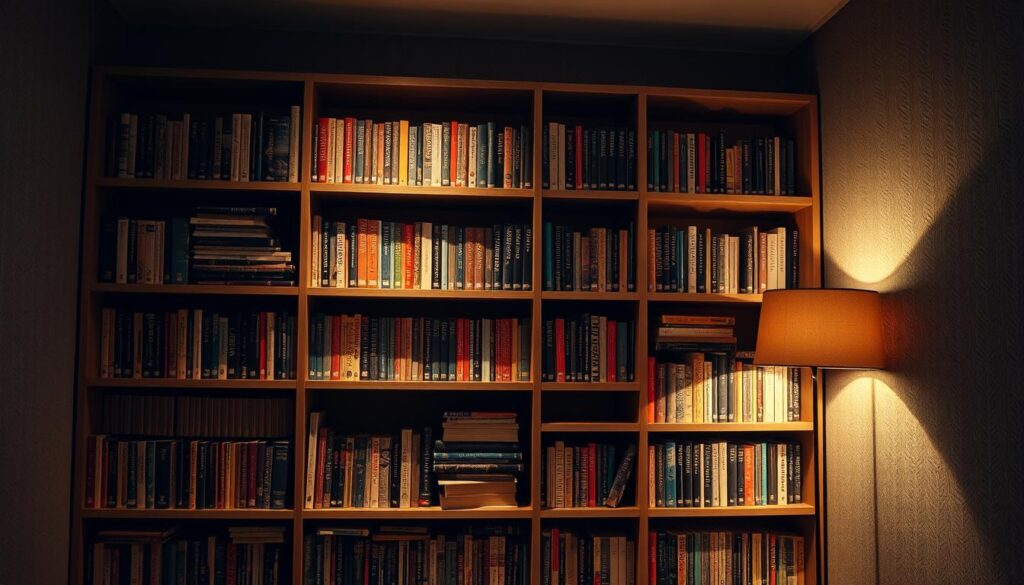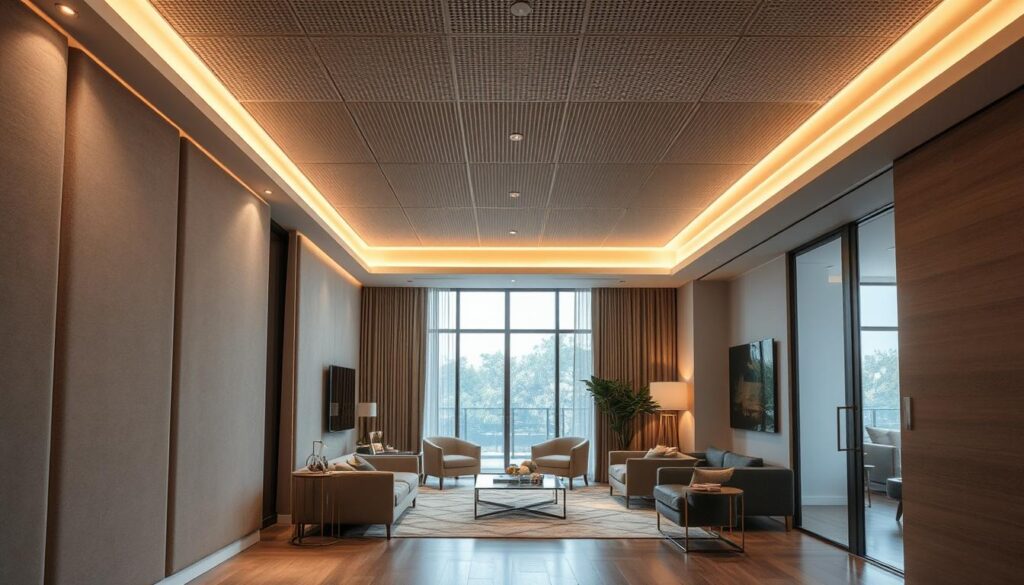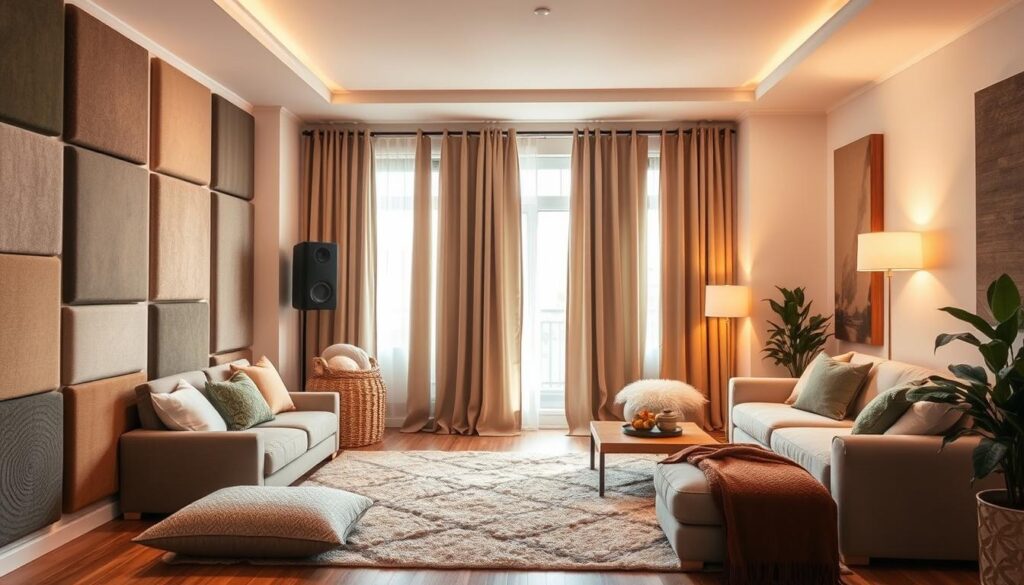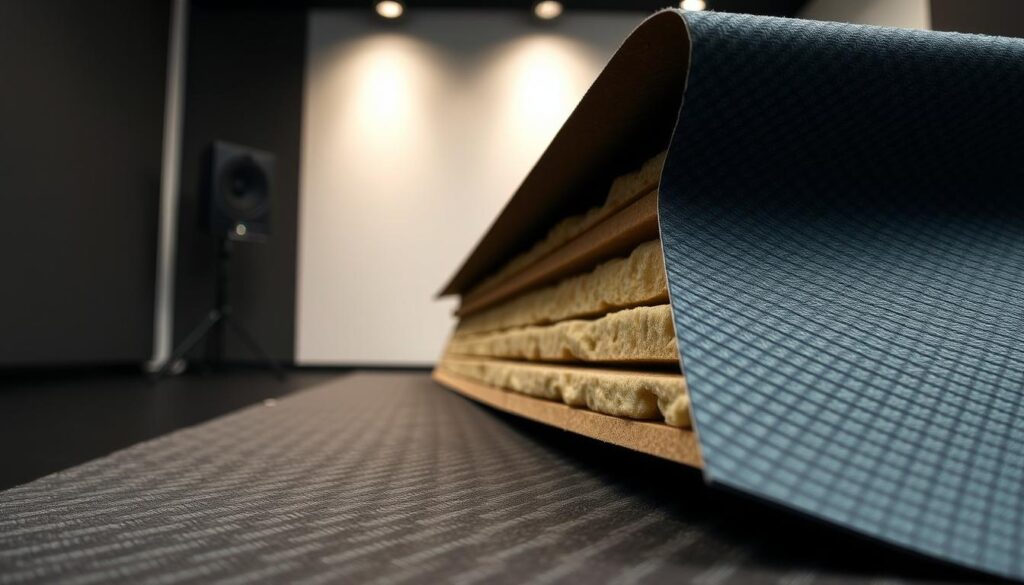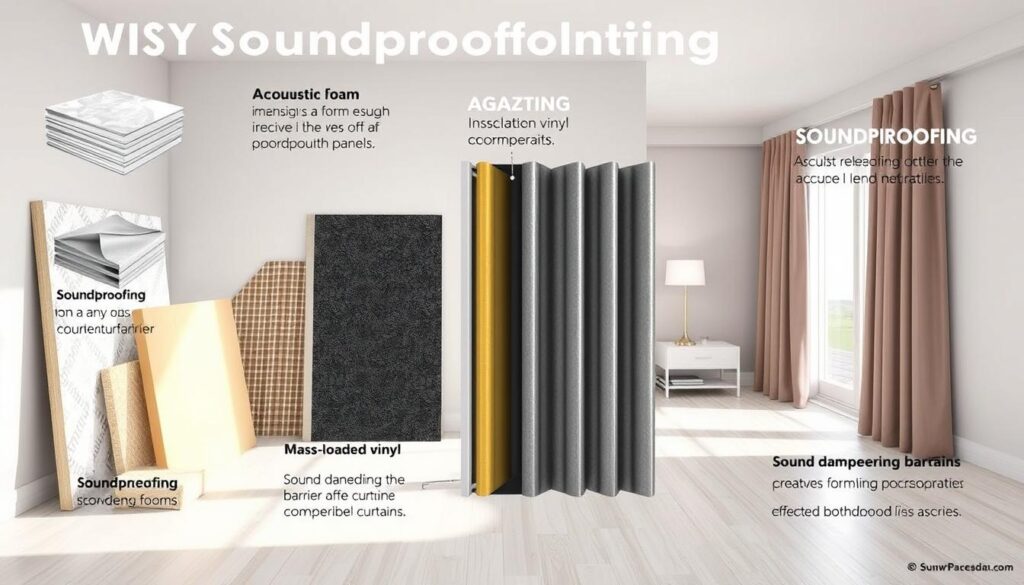Creating a quiet space is key for better reading and relaxation. Studies show that quiet areas boost focus and productivity. A smart way to make your room quieter is by using bookshelves or bookcases for soundproofing. This method also makes your room look better.
To soundproof your room, place bookshelves or bookcases wisely. This method is both affordable and simple. By learning how bookshelves block sound, you can make your home quieter and more peaceful.
Why Soundproofing is Important for Your Space
A peaceful home is possible with soundproofing. It’s not just about blocking noise. It’s about making a space where you can focus, relax, and enjoy your time without distractions.
Reducing noise brings many benefits. It improves concentration, sleep quality, and overall well-being. For example, a DIY soundproof bookcase can make your space soundproof and look good.
Benefits of Reducing Noise
Less noise means less stress, better mental health, and a more peaceful home. Soundproofing your space makes your home quieter and more comfortable.
- Enhanced focus and productivity
- Better sleep quality
- Reduced stress and anxiety
Common Noise Sources in Homes
Noise in homes comes from outside walls, household members or neighbors, and traffic. Knowing these sources helps you soundproof your space effectively.
Understanding noise sources and using soundproofing solutions like soundproofing with furniture can greatly improve your home.
How Bookshelves Can Help Soundproofing
Using bookshelves for soundproofing is a smart idea. It helps reduce unwanted noise in your home. Books and bookshelves work together to block out sound.
Bookshelves can soundproof a room in several ways. Books absorb sound, cutting down on echo and sound reflections. The bookshelf’s design and build also play a big role in blocking or absorbing sound.
The Science Behind Soundproofing with Books
Books work well for soundproofing because they absorb sound energy. When sound hits a book, the pages and cover soak up the vibrations. This makes the room quieter and more peaceful.
Key factors that influence the soundproofing effectiveness of books include:
- The density and thickness of the books
- The arrangement of books on the shelf
- The material and construction of the bookshelf itself
Acoustic Properties of Bookshelves
The soundproofing power of bookshelves depends on their design and materials. A bookshelf full of books can act as a diffusion panel. It scatters sound waves, reducing echo. The type of bookshelf, solid or hollow, also matters.
To get the most out of your bookshelf, choose a sturdy, solid one. Fill it with books of various sizes. This will make your bookshelf a great soundproofing solution that looks good too.
Choosing the Right Location for Your Bookshelf
Putting your bookshelf in the right spot is crucial for soundproofing. To get the most out of your sound-absorbing bookshelves, figure out where the noise is coming from. Then, place your bookshelf in a way that blocks that noise.
Identifying Noise Sources in Your Room
Start by finding out where the noise is coming from. Listen carefully to pinpoint the sound’s origin. It could be from outside or inside your room. Doors, windows, and walls shared with neighbors are common culprits.
Knowing where the noise is coming from helps you place your soundproof shelving for the best results.
Best Placement Tips for Maximum Effect
After finding the noise sources, it’s time to place your bookshelf. Here are some tips:
- Put your bookshelf along a shared wall or near a door to block sound.
- Place it near a window to reduce outside noise.
- Make sure your bookshelf is stable, as it should not fall over.
- Choose a tall bookshelf if your ceiling is high for better soundproofing.
By using these soundproof shelving tips, you can make your bookshelf more effective. This will help make your space quieter.
Selecting the Right Type of Bookshelf
Choosing the right bookshelf is key to better room acoustics. The type of bookshelf you pick greatly affects its soundproofing.
The bookshelf’s construction is vital for sound absorption. A well-made bookshelf can soak up sound waves, cutting down on echo and noise.
Solid vs. Hollow Construction
The material and design of your bookshelf matter a lot for soundproofing. Solid construction bookshelves are better at soundproofing than hollow ones.
Solid bookshelves, made from dense materials, absorb sound waves well. Hollow bookshelves let sound pass through, making them less effective at soundproofing.
Using Filled vs. Unfilled Shelves
Whether to use filled or unfilled shelves is another key choice. Filled shelves boost sound absorption by adding mass and reducing empty space.
Stuffing your bookshelf with books or decorations can quiet your room. Unfilled shelves, lacking mass and with empty space, don’t soundproof as well.
By picking a bookshelf that’s well-designed and filled, you can enhance its soundproofing. This improves your room’s overall sound quality.
Maximizing Your Bookshelf’s Soundproofing Potential
To make your bookshelf better at blocking noise, think carefully about what you put on and around it. The materials you choose for filling it and the items you place nearby are key. They affect how well your bookshelf can reduce noise.
Filling Shelves with Books and Other Materials
Stuffing your bookshelf with books and other items is essential for soundproofing. Different sizes and thicknesses of books can soak up sound waves. This helps cut down on echo and background noise. Mix hardcover and paperback books with decorative boxes or sound-absorbing materials for best results.
Tips for Filling Your Shelves:
- Use a mix of book sizes and types to create a varied surface.
- Incorporate decorative items like vases or sculptures to add visual interest.
- Consider using sound-absorbing materials like acoustic foam or fabric-wrapped panels.
Using Textiles and Decorative Items
Adding textiles and decorative items can also boost your bookshelf’s sound-absorbing power. Hanging curtains or drapes near your bookshelf can catch sound waves. Placing rugs or mats on the floor can also help reduce echo.
| Textile/Decorative Item | Sound-Absorbing Benefit | Additional Tips |
|---|---|---|
| Curtains/Drapes | Absorb sound waves, reduce echo | Choose thick, heavy fabrics for maximum effect. |
| Rugs/Mats | Reduce echo, absorb footstep noise | Select rugs with thick piles or dense weaves. |
| Upholstered Furniture | Absorb sound waves, add comfort | Place furniture near the bookshelf for enhanced effect. |
By carefully choosing what to put on and around your bookshelf, you can improve its soundproofing. This will help make your space quieter and more peaceful.
Supplementing Bookshelves with Additional Techniques
Adding other soundproofing methods to your bookshelves can make them work better. Bookshelves do help block noise, but more techniques can make them even more effective.
One easy way to improve your bookshelves is by using everyday items. For example, curtains and rugs can help soak up sound. This reduces echoes and background noise.
Combining with Curtains and Rugs
Curtains and rugs are more than just for looks. They can also help with soundproofing. Thick curtains can catch sound waves, and rugs can lessen footstep noise.
- Use thick, heavy curtains to absorb sound waves.
- Place rugs in areas where footstep noise is most prevalent.
- Consider using curtain liners or acoustic curtains for added soundproofing.
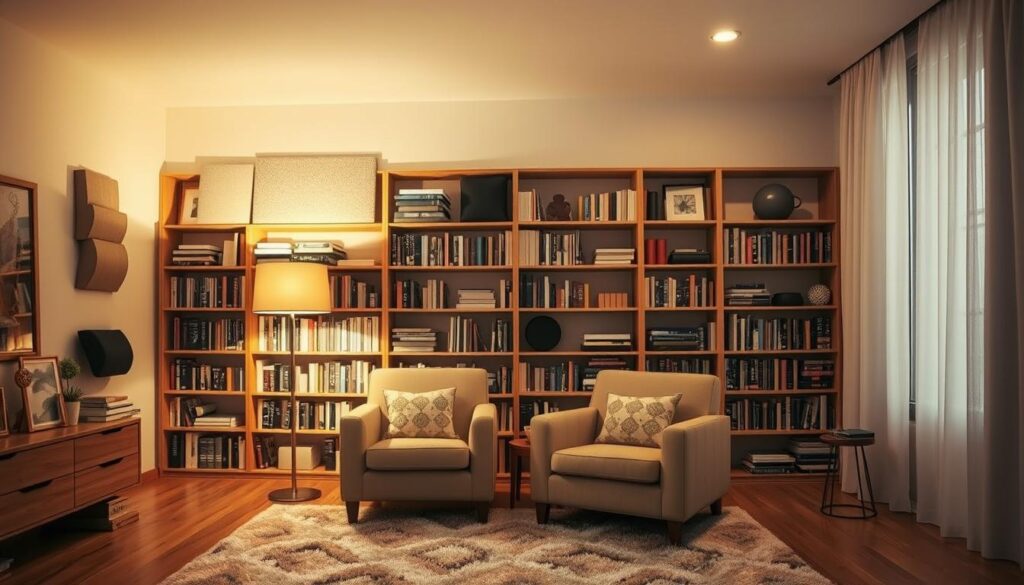
Adding Wall Panels or Foam
Adding wall panels or foam to your bookshelves can also help. Acoustic wall panels can cover big parts of your walls, catching sound waves and cutting down on echoes. Acoustic foam on walls or ceilings works the same way.
| Soundproofing Material | Effectiveness | Cost |
|---|---|---|
| Acoustic Wall Panels | High | Moderate to High |
| Acoustic Foam | Moderate to High | Low to Moderate |
| Curtains and Rugs | Moderate | Low to Moderate |
By mixing these methods, you can make a strong soundproofing system. The secret to good soundproofing is being smart and creative.
DIY Soundproofing Enhancements
Improving your bookshelf’s soundproofing is easy with DIY tweaks and hacks. By making your bookshelf more soundproof, you can cut down on noise at home.
Customizing Your Bookshelf
To boost your bookshelf’s soundproofing, use the right materials and arrangements. Filling shelves with dense objects like books or sound-absorbing materials can absorb sound. You can also rearrange items to make your shelves more dense and soundproof.
Adding mass to your bookshelf is another smart move. Use heavier materials for shelves or add weight to them. Thicker or denser back panels can block sound better.
Creative Soundproofing Hacks
There are creative ways to make your bookshelf soundproof. Using acoustic panels or sound-absorbing foam on the back or walls can absorb sound. This reduces echo.
- Heavy curtains or drapes behind the bookshelf can block sound.
- Area rugs or mats around the bookshelf can cut down echo and footstep noise.
- Seal gaps or cracks with acoustic caulk or spray foam.
By adding these DIY soundproofing tricks to your bookshelf, you can make it more effective. Try different materials and setups to find the best soundproofing for your space.
Maintenance and Adjustments for Permanent Solutions
Keeping your sound-absorbing bookshelves in good shape is crucial. It helps them keep reducing noise well. A tidy bookshelf also makes your room look better and keeps it soundproof.
To keep your bookshelf working well, update its contents often. You don’t have to change everything at once. Just rearranging books or adding new ones can help. You can also put other items or sound-absorbing materials on the shelves to make them better.
Regularly Updating Shelf Contents
Changing what’s on your bookshelf is easy. Just move the books around or add new things. This keeps your bookshelf looking good and sound-absorbing. Think about adding acoustic panels or sound-absorbing materials to the shelves for better soundproofing.
- Rearrange books to create a more dense arrangement, which can help absorb more sound.
- Add new decorative items or sound-absorbing materials to the shelves.
- Consider using baskets or containers to add more sound-absorbing surfaces.
Adjusting Shelf Position as Needed
The spot where you put your bookshelf matters for soundproofing. If you know where the noise is coming from, move the bookshelf to block it. For example, if the noise is from one direction, place the bookshelf there to catch it better.
Check the noise levels often and move the bookshelf if needed. This keeps it working well as a soundproofing tool. You can also use curtains or rugs with your bookshelf to make your room even quieter.
Cost Considerations for Soundproofing
When you think about soundproofing your space, it’s key to look at the costs. Using bookshelves or bookcases can be a smart, budget-friendly choice. But, knowing the costs helps you make a better decision.
One big plus of using bookshelves for soundproofing is you might not have to spend much. You can use furniture you already have. Or, if you need a new bookshelf, there are affordable options. You can find deals at thrift stores, second-hand shops, or online.
Budget-friendly Options for Bookshelves
Here are some ways to find cheap bookshelves:
- Look for sales or use discount codes when buying new bookshelves.
- Choose simpler designs or make your own to save money.
- Check online or local classifieds for used or refurbished bookshelves.
- Visit stores that sell affordable soundproofing materials, like Soundproof Cow, for budget-friendly options.
Weighing Costs vs. Benefits
To decide if soundproofing with bookshelves is right for you, compare costs and benefits. Think about these points:
- How much noise you want to block and if bookshelves can do it.
- The price of the bookshelf and any extra materials you’ll need.
- The good things it might bring, like better focus, sleep, or overall health.
By looking at these points, you can decide if soundproofing with bookshelves fits your needs and budget.
Real-Life Examples of Successful Soundproofing
Bookshelves can really help cut down on noise. Homeowners have found that placing them in the right spots can block out a lot of outside sounds. It’s not just about sound; it also makes your home look good by showing off your favorite things.
Case Studies of Bookshelf Soundproofing
Many case studies show how bookshelves can be great for soundproofing. For example, a city dweller used a big bookshelf to keep street noise out. They filled it with books and decorations, making their living room much quieter. You can find more design-minded sound dampening hacks to improve your soundproofing.
User Testimonials and Experiences
People share their experiences with bookshelf soundproofing, and it’s really helpful. Many say they’ve noticed a big drop in noise levels. For instance, one person said a bookshelf against a noisy neighbor’s wall made their home much quieter.
It’s not just homes that benefit. Libraries and home offices also use bookshelves to make their spaces quieter. Learning how to use bookshelves for soundproofing can make your home or office a more peaceful place.
Conclusion and Final Tips
Soundproofing a room with bookshelves or bookcases is a smart and creative way to cut down on noise. It helps make your space a calm place for reading, relaxing, and focusing. By using the strategies we’ve talked about, you can turn your area into a peaceful retreat.
Key Strategies Recap
To get the most out of soundproofing with bookshelves, think about where you put them and what they’re made of. Place them in spots to block out noise. Choose solid, filled shelves for better sound blocking.
Customizing Your Soundproofing Approach
Try out different bookshelf setups and add more soundproofing tricks like curtains, rugs, or wall panels. For more ideas, look into various materials and solutions for your home library. This way, you can find the right mix of function and beauty.
By using these tips and techniques, you can make a quieter, more productive space. Start using bookshelves or bookcases for soundproofing today. Enjoy a more peaceful environment.
